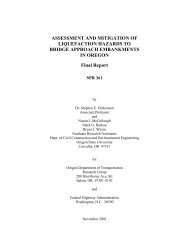Oregon Balance of State HIV/AIDS Housing & Services Systems ...
Oregon Balance of State HIV/AIDS Housing & Services Systems ...
Oregon Balance of State HIV/AIDS Housing & Services Systems ...
Create successful ePaper yourself
Turn your PDF publications into a flip-book with our unique Google optimized e-Paper software.
<strong>Oregon</strong> <strong>HIV</strong>/<strong>AIDS</strong> <strong>Housing</strong> and <strong>Services</strong> <strong>Systems</strong> Integration Plan—Appendices A-53<br />
Section 811 - Supportive <strong>Housing</strong> for Persons with Disabilities<br />
http://www.hud.gov/<strong>of</strong>fices/hsg/mfh/progdesc/disab811.cfm<br />
Nonpr<strong>of</strong>it organizations can use Section 811 funds to construct, acquire, and/or rehabilitate supportive<br />
housing for very low-income persons with disabilities, including those with disabilities resulting from <strong>HIV</strong>infection.<br />
The support services should address the residents’ individual needs, provide optimal independent<br />
living, and provide access to the community and employment opportunities.<br />
Section 811 funding is provided in two parts: a one-time capital advance, essentially a grant, to fund<br />
development, and ongoing project-based rental assistance that pays the difference between the tenant<br />
payment and the operating cost.<br />
<strong>Housing</strong> Choice Voucher (Section 8) Rental Assistance Programs<br />
http://www.hud.gov/<strong>of</strong>fices/pih/programs/hcv/about/index.cfm<br />
The <strong>Housing</strong> Choice Voucher Program (formerly called the Section 8 Program) provides vouchers which are<br />
administered by public housing authorities. Vouchers allow income-eligible households to find and obtain<br />
rental housing independently. Tenants typically pay 30 percent <strong>of</strong> their income, while the voucher pays the<br />
difference, up to the HUD-established Fair Market Rent (FMR) for the area. A tenant can pay more than 30<br />
percent <strong>of</strong> their income if the cost <strong>of</strong> the unit exceeds the FMR, but cannot pay more than 40 percent <strong>of</strong> their<br />
income.<br />
Public housing authorities can also designate up to 15 percent <strong>of</strong> their vouchers to be project-based in new<br />
construction or rehabilitated housing. Project-based vouchers stay with a particular unit, so that incomeeligible<br />
tenants can come and go, but the unit stays affordable. Tenants cannot take the vouchers away from<br />
the unit for use elsewhere.<br />
<strong>Housing</strong> Choice Vouchers for People with Disabilities (Mainstream Program)<br />
http://www.hud.gov/<strong>of</strong>fices/pih/programs/hcv/pwd/mainstream.cfm<br />
In Fiscal Year 1997, HUD moved a portion <strong>of</strong> the funds originally earmarked for the Supportive <strong>Housing</strong> for<br />
Persons with Disabilities (Section 811) program to create this separate tenant-based program. The <strong>Housing</strong><br />
Choice Vouchers for People with Disabilities (Mainstream Program) provides vouchers to persons with<br />
disabilities to allow for more housing choice.<br />
Low Income <strong>Housing</strong> Tax Credits<br />
http://www.huduser.org/datasets/lihtc.html<br />
Created in 1986, the Low Income <strong>Housing</strong> Tax Credit allows qualified owners <strong>of</strong> or investors in eligible lowincome<br />
rental housing to reduce their federal income taxes on a dollar-for-dollar basis for a ten-year period,<br />
subject to compliance. Low-income housing developers use these credits to attract investors, who commit to<br />
funding a project in return for the tax credit.<br />
Available tax credit dollars are allocated to states based on population, equal to $1.75 per capita in 2002 and<br />
adjusted for inflation thereafter. <strong>State</strong>s administer their own competitive process for the credits. The Low<br />
Income <strong>Housing</strong> Tax Credit program has become the primary federal resource for developing low-income

















